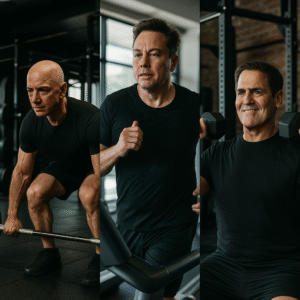Embarking on a fitness journey often involves more than just showing up at the gym and breaking a sweat. It requires a comprehensive understanding of proper form and technique to maximize results while minimizing the risk of injury. Whether you’re a seasoned gym-goer or just starting out, the significance of maintaining proper form during workouts cannot be overstated. In this blog post, we delve into the pivotal role that correct form plays in personal training. Proper form isn’t just about aesthetics; it’s about functionality and safety. It ensures that muscles are targeted effectively, facilitating optimal growth and strength development. Moreover, correct alignment during exercises reduces the strain on joints and ligaments, mitigating the chances of injury that could derail your progress. Join us as we explore the various benefits of prioritizing form in your personal training regimen and discover how it can propel you towards your fitness goals with confidence and resilience.
Maximizing Efficiency: How Proper Form Enhances Workouts
In the pursuit of fitness goals, whether it’s building muscle, losing weight, or improving overall health, efficiency is key. Every minute spent in the gym should count towards progress. One of the most crucial factors influencing the efficiency of workouts is proper form. While it might seem like a minor detail, correct form plays a significant role in optimizing the effectiveness of every exercise. Let’s delve deeper into how proper form enhances workouts and maximizes results.

Muscle Activation and Targeting
Proper form ensures that the targeted muscles are effectively engaged during an exercise. For example, in a squat, maintaining proper alignment of the knees, hips, and spine ensures that the quadriceps, hamstrings, and glutes are activated optimally. Without proper form, other muscle groups may compensate, leading to imbalances and reduced effectiveness of the exercise.
Injury Prevention
One of the primary reasons for emphasizing proper form is injury prevention. When performing exercises with incorrect form, joints and muscles are subjected to unnecessary stress, increasing the risk of strains, sprains, and other injuries. By adhering to proper form, individuals can minimize the likelihood of injuries, allowing for consistent training and progress over time.
Improved Range of Motion
Proper form often involves maintaining a full range of motion in each exercise. This not only maximizes muscle activation but also enhances flexibility and mobility. Over time, improved range of motion leads to better movement patterns and reduces the risk of injury during both workouts and daily activities.
Increased Intensity and Efficiency
Correct form allows individuals to lift heavier weights or perform more repetitions safely. By maximizing intensity through proper form, workouts become more efficient, leading to greater muscle stimulation and adaptation. Whether the goal is muscle growth or fat loss, higher intensity translates to better results in less time.
Mind-Muscle Connection
Proper form encourages the development of the mind-muscle connection, where individuals consciously engage the targeted muscles during exercises. By focusing on proper form and feeling the muscles working throughout each repetition, individuals can enhance muscle activation and stimulate growth more effectively.
Mind-Muscle Connection: Harnessing Proper Form for Better Results
The mind-muscle connection is a powerful tool in the realm of fitness, often overlooked but essential for maximizing results. By consciously engaging specific muscles during exercises and maintaining proper form, individuals can unlock a deeper level of muscle activation, leading to superior gains and improved performance.
- Conscious Engagement: The mind-muscle connection involves focusing on the targeted muscle group during an exercise, allowing for greater activation and recruitment of muscle fibers.
- Proper Form Amplifies Connection: Maintaining correct form is crucial for enhancing the mind-muscle connection. Proper alignment ensures that the intended muscles are being properly engaged, leading to more effective workouts.
- Enhanced Muscle Activation: By harnessing the mind-muscle connection through proper form, individuals can increase muscle activation and stimulate greater muscle growth, leading to better results over time.
- Improved Symmetry and Balance: Developing a strong mind-muscle connection helps to address muscle imbalances and promote symmetry throughout the body, reducing the risk of injuries and enhancing overall aesthetics.
The Role of Personal Trainers: Guiding Clients Towards Proper Form
Personal trainers serve as invaluable guides on individuals’ fitness journeys, offering expertise, motivation, and support. Among the many facets of their role, one of the most critical is ensuring clients perform exercises with proper form. In this article, we’ll explore the multifaceted ways in which personal trainers guide their clients towards mastering correct form, thereby maximizing the effectiveness and safety of their workouts.
Establishing Baseline Assessments
Before delving into workouts, personal trainers conduct comprehensive assessments to understand clients’ fitness levels, strengths, weaknesses, and any existing injuries or limitations. These assessments serve as the foundation for tailoring exercise programs and emphasizing the importance of proper form based on individual needs.
Education on Anatomy and Technique
Personal trainers educate clients about anatomy and biomechanics, providing insights into how each exercise affects specific muscles and joints. By understanding the mechanics behind movements, clients gain a deeper appreciation for the significance of proper form in optimizing results and minimizing injury risk.
Demonstration and Explanation
Demonstrating proper form is a cornerstone of personal training sessions. Trainers meticulously showcase each exercise, emphasizing key points such as alignment, posture, and range of motion. They explain the purpose behind each movement and offer cues to help clients execute exercises correctly.
Cueing and Feedback
Throughout workouts, personal trainers provide real-time feedback and cues to ensure clients maintain proper form. They offer verbal cues on alignment, breathing, and muscle engagement, guiding clients to make adjustments as needed. Visual cues and tactile feedback may also be utilized to enhance clients’ understanding and execution of exercises.
Progression and Regression
Personal trainers tailor exercises to clients’ abilities, gradually progressing or regressing difficulty levels as needed. They ensure clients master basic movement patterns before advancing to more complex exercises, prioritizing proper form at every stage of progression. By gradually challenging clients within their capabilities, trainers foster continuous improvement while minimizing injury risk.
Conclusion
Results Transformation Center, we recognize the paramount significance of maintaining proper form in personal training. It is not merely about achieving short-term results but also about fostering long-term health and fitness. Through our commitment to emphasizing correct techniques, we prioritize injury prevention, optimize workout efficiency, and ensure sustainable progress for our clients. By adhering to proper form, we empower individuals in Sparks, Nevada, and beyond to achieve their fitness goals safely and effectively, fostering a culture of wellness and longevity in our community.








